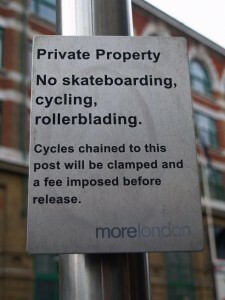Chartered Streets
Jon Day has his bike clamped
To a cycle courier, the conflict between public and private, between the rules of the road and those of corporate estates, is constantly apparent. The glee with which the police hunt down and fine couriers who jump red lights, while letting off their commuting counterparts, is well known. But the guardians of private land are just as intolerant.
Sometimes, proclamations of ownership are local and specific, like the small ‘Polite Notices’, which read as anything but, informing you that ‘Bicycles locked to these railings will be removed’. Elsewhere the limits of ownership spill out beyond the railings. Representatives of the ‘West End Company’ patrol Oxford Street in red hats, giving tourists directions and admonishing cyclists who ride on the pavements. Some large commercial estates, such as Devonshire Square off Bishopsgate in EC1, have their own private police force. Anyone who isn’t obviously an office worker, snatching a lunchtime sandwich in the open air, is moved on. Running is forbidden.
The ‘More London’ development, designed by Foster and Partners, which squats on Tooley Street to the west of the new City Hall, is one of the worst offenders. According to its website, ‘More London is an economic solution providing value for money office space which will enhance retention and recruitment of staff by virtue of the environment and amenities.’
Its loading bay is cavernous, serving all of the seven large buildings above, and taking up an almost equal area underground. It’s a dangerous place to be on a bike: there are lorries to be dodged, strange one-way systems to be observed, oil slicks and wet patches to be avoided. Security staff in fluorescent jackets choreograph the traffic in a bored, slow dance.
Half of the development above ground is supposedly public space. Even so, and although the estate plays host to the cycle-friendly mayor of London and the GLA, More London has a policy of fining cyclists who lock their bikes up anywhere on its land. There is no bicycle parking space provided on Tooley Street, and even bikes chained to the lampposts next to the road will be clamped: there’s a £50 charge to have the clamp removed.
It’s hard to see the point of this. It can’t be intended as an active deterrent: the small warning sign on one of the lamp posts is easy to miss. Could More London really be dependent on income from renegade cyclists, filling the coffers £50 at a time? It seems unlikely. Southwark Cyclists, a local pressure group, has asked More London to put up clearer signs and provide a place where people can lock up their bikes. They haven’t.
So it’s fortunate that the locks used by the More London security staff are flimsy things. If you ever find yourself caught out, a sharp rap with a heavy D-lock, or two minutes with a hacksaw, ought to be enough to remove them.


Comments
Thanks for tracking down Leo and publishing his comments. We'd been wondering where he'd got to and how he was doing. Please let him know that us seals down here at the Cape Town Waterfront are also getting ready to make a run for it. It's been bad enough having the tourists disturbing us all day, but the floating stage they've put up for rock concerts right next to our favourite jetty and the prospect of thousands of soccer hooligans lobbing empty beer cans at us have made us barking mad, so we're off. We've found a lovely little cove on the backside of Robben Island that gets the boys' seal of approval.